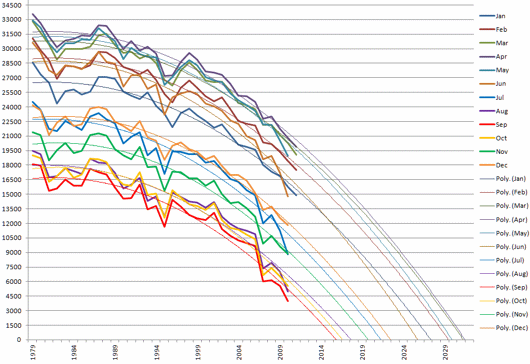Across the sea ice blogosphere today a great amount of discussion has been dedicated to the subject of sea ice volume. You can take a look at some of this discussion over at Neven’s Arctic Ice Blog.
The general gist is that, for the past few years, the Arctic sea ice community has been cautious about accepting data from PIOMAS. The researchers there model sea ice volume by plugging Arctic Ocean observations into a computer simulation. However, over that time, the trends established by the PIOMAS data have born out in larger Arctic melt trends.
This summer, a group of British scientists validated the PIOMAS findings by using satellite data from Cryosat2. Interestingly, these British scientists came to the same conclusion that many studies of PIOMAS data have pointed to — the Arctic Ocean could be ice-free at summer’s end within the next ten years.
Almost as soon as the British published their Cryosat2 data, the Arctic began to experience another record decline in sea ice area and extent. The visible losses in extent and area have been, for many, enough evidence to take seriously the notion of a nearly ice-free Arctic in a much shorter span than was previously predicted.
Given the increasing acceptance of sea ice volume data and of the conclusions that can be drawn by sea ice data trends, it is important to provide a brief summary of what the volume trends from PIOMAS have been. In short, what PIOMAS and Cryosat2 have revealed is a stunning loss of sea ice and a potential for the total loss of Arctic Ocean ice over a much shorter period than previously thought.
In 1979, the total volume of sea ice according to PIOMAS was about 16,000 cubic kilometers. Today, PIOMAS shows sea ice volume at 3,600 cubic kilometers. This is a total loss of 12,400 cubic kilometers or about 78% of all ice in the Arctic Ocean at the end of summer since 1979. As noted before, at the current rate of melt, volume measurements indicate the Arctic could be ice-free within ten years.
For a visual of the current trends, take a good look at this graph of PIOMAS data produced by Neven:
This is a curve fitting process. So any conclusions drawn from it should be taken in understanding of the limitations of curve fitting.
The last data points are from 2011. Plugging in the values for August of 2012 would show a new volume low of 3,600 cubic kilometers — about 1,100 cubic kilometers below the 2011 measure of around 4,700 cubic kilometers. Final numbers for September 2012 aren’t yet in.
Stepping back, however, you can see a pretty severe melt trend. End of summer sea ice volume reaches about zero by 2017 following the curve. Even more disturbing, the Arctic becomes almost entirely ice-free year-round by 2032 if the trend lines for current decline rates hold.
The only science team yet to validate the potential for an ice-free Arctic during summer within ten years has been those investigating the Cryosat2 results. No-one has yet to validate the potential for an ice-free Arctic year-round by the mid 2030s. Yet this is the potential current melt trends reveal.
It is astonishing to me that such information has received almost zero attention from mainstream news sources. A recent article in the Opinion section of the Washington Post noted the potential for ice-free summers in the Arctic within the next 30 to 40 years. If the volume trends hold out, this article will be a vast underestimation. Perhaps even more disheartening is the article’s conclusion which seems to celebrate the ice free Arctic Ocean while turning a blind eye to the huge masses of ice of Greenland and West Antarctica which are bound to be the next to melt. The writer seems to also be completely unaware of the massive volumes of greenhouse gasses stored in the permafrost and methane hydrates in the region. The same gasses which are bound to amplify human-caused global warming even further.
I’m reminded of the irrational exuberance of economists and investors prior to the financial collapse of 2008. Even the bad indicators were considered ‘good.’ Let’s hope the derivatives of sea ice melt don’t come crashing down with even more terrible consequences. Lacking sound world-wide climate policy, a flimsy shred of hope seems to be all we have.







